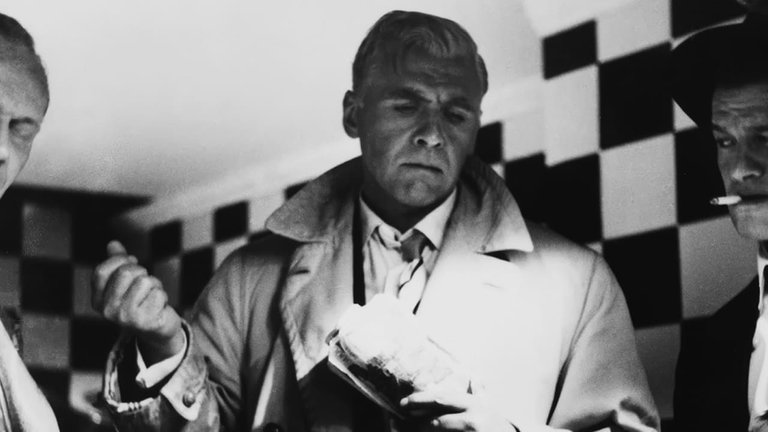Film Review: Bob le flambeur (1956)

France, known as the birthplace of the Auteur Theory, has produced a remarkable number of acclaimed film directors, many of whom have become synonymous with specific genres. One such example is Jean-Pierre Melville, whose stylish and highly influential gangster films have left an indelible mark on cinema. Among his earliest classics is the 1956 film Bob le flambeur, a title that translates to "Bob the Gambler" or "Bob the High Roller."
The protagonist, played by Roger Duchesne, is Bob Montagné, middle aged gambler and ex-convict who has generally stayed out of trouble for the past twenty years, thus allowing him to liver relatively comfortable life in picturesque Parisian district of Montmartre. His generosity and adherence to traditional values made him into respected and popular figure among local demi-monde, and his circle of friends even includes Commissioner Ledru (played by Guy Decomble), police detective whose life had saved. Bob has recently suffered from bad luck and, following a disastrous night in Deuaville casino, he gets an idea to rob the establishment. After receiving inside information about the safe, Bob gathers the team, secures finances and hatches the plan for a daring heist. The scheme, however, gets compromised when Bob’s young protege Paulo (played by Daniel Cauchy) tells about the heist to Anne (played by Isabelle Corey), his girlfriend who lacks sense of discretion.
While Jean-Pierre Melville is not officially considered part of the French New Wave, he was revered by the leaders of the movement as a role model and honorary member, a sentiment he reciprocated with a cameo appearance in Godard's 1959 film Breathless. In Bob le flambeur, traces of the French New Wave can be found in the quasi-documentary opening scenes showcasing the streets of Montmartre, the use of handheld cameras, and the incorporation of jump cuts – techniques that would later become hallmarks of the New Wave auteurs like Truffaut and Godard.
Critics have often interpreted Bob le flambeur as Melville's love letter to classic Hollywood gangster films and the film noir genre. The post-World War II fascination of French filmmakers with American culture is evident in various details of the film, from Anne's encounter with a US Navy sailor to Bob's sleek American car and the financial backing from the presumably American crime boss McKimme (played by Swiss actor Howard Vernon). This Americanisation is even referenced by the characters, who lament that French gangsters have begun mimicking their American counterparts, only to be reminded that Dillinger and 1930s gangsters were inspired by the infamous Bonnot Gang in France two decades earlier.
Despite its nods to American influences, Bob le flambeur remains unmistakably French, drawing comparisons to earlier French gangster classic Touchez pas au grisbi. Both films delve into the Parisian crime underworld, exploring themes of loyalty, betrayal, and the harsh realities of criminal life. The middle-aged protagonists in both films, while adhering to a strict code of honour and impeccable fashion sense, navigate a world governed by their own moral codes, offering a cynical yet authentic portrayal of crime driven by greed and treachery.
One of the standout aspects of Bob le flambeur is Melville's inspired sense of casting. The protagonist, Bob, is played by Roger Duchesne, a middle-aged actor who lacks the charisma of Jean Gabin in Touchez pas les grisbi but compensates with a convincing display of world-weariness and self-delusion. Melville also avoids film noir clichés by casting 16-year old Isabel Corey as the closest thing to a femme fatale. Corey portrays Anne as an ordinary "girl next door" type, not particularly bright but open about using her sexuality to get ahead in the sleazy streets of Montmartre. Her semi-naked appearances in several scenes, combined with the film's exploration of prostitution, add to the overall realism of the French thriller compared to similar Hollywood films of the time.
Bob le Flambeur had relatively low box office numbers upon its release, but it was celebrated by influential critics and later gained a cult reputation among the most discerning filmmakers, including Stanley Kubrick and Quentin Tarantino. In 2002, Neil Jordan directed a remake titled The Good Thief, starring Nick Nolte.
Melville's masterful direction, coupled with his rejection of film noir clichés and a semi-ironic ending, solidifies Bob le flambeur as a seminal work in the gangster genre and a testament to the lasting impact of French auteurs on world cinema.
RATING: 9/10 (++++)
Blog in Croatian https://draxblog.com
Blog in English https://draxreview.wordpress.com/
InLeo blog https://inleo.io/@drax.leo
Hiveonboard: https://hiveonboard.com?ref=drax
Rising Star game: https://www.risingstargame.com?referrer=drax
1Inch: https://1inch.exchange/#/r/0x83823d8CCB74F828148258BB4457642124b1328e
BTC donations: 1EWxiMiP6iiG9rger3NuUSd6HByaxQWafG
ETH donations: 0xB305F144323b99e6f8b1d66f5D7DE78B498C32A7
BCH donations: qpvxw0jax79lhmvlgcldkzpqanf03r9cjv8y6gtmk9
Posted Using InLeo Alpha
Yeehaw! This blog post is a thrilling gallop through the world of French cinema!